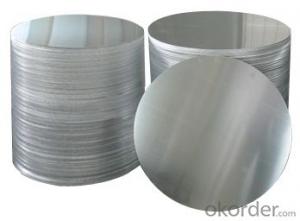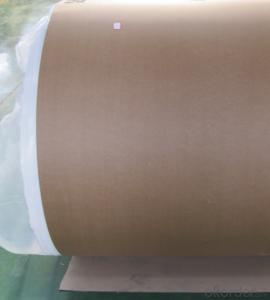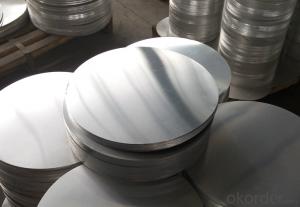Extruded Aluminum Ribbed Sheets - Aluminium Circle 1050 1060 1070 3003 for Cookware
- Loading Port:
- Shanghai
- Payment Terms:
- TT OR LC
- Min Order Qty:
- 1 m.t
- Supply Capability:
- 5000 m.t/month
OKorder Service Pledge
OKorder Financial Service
You Might Also Like
Product Introduction
Aluminum Circle/Disc is mainly used for general commercial and industrial uses, like the capacitor case, toothpaste case, medical tubes, kitchen ware, spray bottle, cosmetic case and glue tube case etc. With
high quality casting and rolling coils or hot-rolled coils as raw materials ,it goes through different cold r
olling deformation. slitting, annealing and finally stamping into an aluminum disc, then packaging for
delivery.
Product Process
Ingot/Master Alloys - Melting Furnace – Holding Furnace - D.C. Caster - Slab - Scalping - Hot Rolling Mill
–Cold Rolling Mill – Punching – Annealing Furnace - Final Inspection – Packing - Delivery
Specification | aluminium circles prices | |||||||||||
Alloy: 1050, 1060,1070, 1100, 1200,3003 etc. | ||||||||||||
Temper: O, H12, H22, H14, H24, H26, H18 etc. | ||||||||||||
Thickness: 0.2-200mm | ||||||||||||
Width: Up to 1800mm | ||||||||||||
Length: Up to 6000mm | ||||||||||||
Surface treatment: mill finished, anodized, embossed, PVC coated | ||||||||||||
Feature | Price is much more competitive than that of other series. | |||||||||||
Satisfy regular industrial process of stamping, drawing with good elongation, tensile strength and high formability. | ||||||||||||
Great plasticity, corrosion resistance, electrical conductiviy and termal conductivity. | ||||||||||||
Easy to be welded. | ||||||||||||
Easy to be pressure processed, extended and bent. | ||||||||||||
Application | Sign board, Advertising board, Building decoration, Car body, Cooking utensil, Lamp holder, Fan leaf, Electrical part, Chemical instrument, Machined part, Deep-drawn or spinned part, Welded part, Heat exchanger, Clock surface, Decotation, Reflective instrument etc. | |||||||||||
Alloy | Chemical Component %≤ | |||||||||||
Si | Fe | Cu | Mn | Mg | Cr | Ni | Zn | Ti | others | Al | ||
single | total | |||||||||||
1050 | 0.25 | 0.4 | 0.05 | 0.05 | 0.05 | \ | \ | 0.05 | 0.03 | 0.03 | \ | 99.50 |
1060 | 0.25 | 0.35 | 0.05 | 0.03 | 0.03 | \ | \ | 0.05 | 0.03 | 0.03 | \ | 99.60 |
1100 | 0.95 | 0.05-0.2 | 0.05 | \ | \ | \ | 0.1 | \ | 0.05 | 0.15 | 99.00 | |
1200 | 1.00 | 0.05 | 0.05 | \ | \ | \ | 0.1 | 0.05 | 0.05 | 0.15 | 99.00 | |

- Q: Hi everyone, I have this problem that I'm somewhat confused about. The problem is:An alloy of aluminum and magensium was treated with sodium hydroxide solution, in which only aluminum reacts to give hydrogen gas:2Al + 2NaOH + 6H20 --gt; 2NaAl(OH)4 + 3H2If a sample of alloy weighing 1.118 g gave 0.1068 g of hydrogen, what is the percentage aluminum in the alloy?How do I account for the magnesium and what stoichiometric relationships would I need to set-up? This is very confusing, but I appreciate the slightest of help on this!Thank you.
- Aluminum foil
- Q: The user is inquiring if it's possible to incorporate recycled aluminum sheets into their project.
- <p>Yes, you can use recycled aluminum sheets in your project. Recycled aluminum is not only environmentally friendly but also cost-effective. It maintains the same strength and durability as new aluminum, making it suitable for various applications. Ensure the recycled aluminum meets your project's specifications and quality standards. Always check for any impurities or inconsistencies that might affect the performance of your project. Using recycled materials can also contribute to sustainability and reduce waste.</p>
- Q: Can aluminum sheets be welded or soldered?
- Yes, aluminum sheets can be welded or soldered. However, the process for each differs significantly. Welding aluminum typically involves using a TIG (Tungsten Inert Gas) or MIG (Metal Inert Gas) welding process, which requires a high heat source and a filler material to join the sheets together. The process can be more challenging compared to welding steel due to aluminum's high thermal conductivity and lower melting point. Soldering aluminum, on the other hand, is a process that involves using a low-temperature solder and flux to bond the sheets together. Specialized solders, such as aluminum solder or solder with a high percentage of tin, are typically used. Soldering aluminum is generally less common and more difficult compared to soldering other metals due to aluminum's oxide layer, which can prevent proper adhesion. In summary, while both welding and soldering can be used to join aluminum sheets together, welding is the more commonly used method due to its stronger and more durable results. Soldering aluminum can be more challenging due to the need for specialized solders and the presence of the oxide layer.
- Q: Can the export quality of China's aluminum plate meet the requirement of ASTM B 209? Is this requirement for our country? Master the exhibitions, O (a _ U) O thank you
- ASTM B209 standards for aluminum materials developed by us Materials LaboratoryThe corresponding domestic standards for GB/T 3880, but 3880 standards in many places and B209 there are many differences, some domestic manufacturers can be produced in accordance with B209.
- Q: Is it possible to use aluminum sheets as a material for exterior siding or cladding on buildings?
- <p>Yes, aluminum sheets are commonly used for siding or cladding due to their durability, lightweight, and resistance to corrosion. They are low maintenance, can be easily shaped, and come in various colors and finishes. Aluminum's resistance to weathering and its ability to withstand temperature extremes make it a popular choice for both residential and commercial buildings.</p>
- Q: Are the aluminum sheets suitable for manufacturing sporting equipment?
- Aluminum sheets prove to be a suitable choice for the production of sporting equipment. This is due to aluminum being a material that is both lightweight and durable, offering various advantages in the manufacturing process. Its exceptional strength-to-weight ratio makes it highly suitable for applications where strength is necessary, while still keeping the overall weight of the equipment low. Moreover, aluminum possesses a high level of resistance to corrosion, a crucial quality for sporting equipment that is frequently exposed to diverse weather conditions. In addition to this, aluminum can be easily molded into different shapes and sizes, granting manufacturers the ability to create personalized equipment for a range of sports. In summary, utilizing aluminum sheets in the manufacturing of sporting equipment guarantees the creation of top-quality, lightweight, and long-lasting products that enhance performance and durability.
- Q: Can aluminum sheets be easily shaped or bent into desired forms?
- Yes, aluminum sheets can be easily shaped or bent into desired forms. Aluminum is a highly malleable metal, which means it can be easily manipulated without breaking or cracking. Its low density and high strength-to-weight ratio make it an ideal choice for various applications where shaping or bending is required. Aluminum sheets can be shaped or bent using a variety of methods, including press-braking, roll-forming, or using specialized tools such as a sheet metal brake. The ease of shaping or bending aluminum sheets also makes it a popular choice for industries such as automotive, aerospace, construction, and manufacturing, where customized forms and designs are often needed.
- Q: i bought a light fixture for my bathroom wall and the ground wire is aluminum and the existing ground wire in the wall is copper,so i would like to know if i can join them and if so,how?
- I assure you that if the light fixture was manufactured in the last 10 years, that ground wire is not aluminum. It may look aluminum but it isn't. aluminum small gauge wire for electricity has been illegal for many years. Why? It will create sparks eventually. --- So you can join that aluminum-looking ground wire to your house ground wire. (Make sure the connection is super tight - in case some nutcake put an aluminum wire for the light fixture ground) If you are still in doubt -- just replace the aluminum-looking ground wire at the fixture and replace it with a copper groung wire) btw: (aluminum is stlll allowed in heavy gauge wires from transformers to service entry panels (if they are greased at the service entry panel)
- Q: Can aluminum sheets be anodized for improved corrosion resistance?
- Yes, aluminum sheets can be anodized for improved corrosion resistance. Anodizing is an electrochemical process that creates a protective oxide layer on the surface of the aluminum, increasing its resistance to corrosion and wear. During anodizing, the aluminum sheet is submerged in an electrolyte bath and an electric current is passed through it. This causes oxygen ions to bond with the aluminum, forming a thick, dense layer of aluminum oxide on the surface. This oxide layer acts as a barrier, preventing moisture and other corrosive substances from reaching the underlying metal. Anodized aluminum sheets have enhanced durability, longevity, and resistance to corrosion, making them ideal for various applications such as architectural, automotive, and aerospace industries. Additionally, anodized aluminum can be dyed in a wide range of colors, providing aesthetic appeal along with the enhanced corrosion resistance.
- Q: Is aluminum sheet resistant to UV rays?
- Yes, aluminum sheet is resistant to UV rays.
Send your message to us
Extruded Aluminum Ribbed Sheets - Aluminium Circle 1050 1060 1070 3003 for Cookware
- Loading Port:
- Shanghai
- Payment Terms:
- TT OR LC
- Min Order Qty:
- 1 m.t
- Supply Capability:
- 5000 m.t/month
OKorder Service Pledge
OKorder Financial Service
Similar products
Hot products
Hot Searches
Related keywords

























